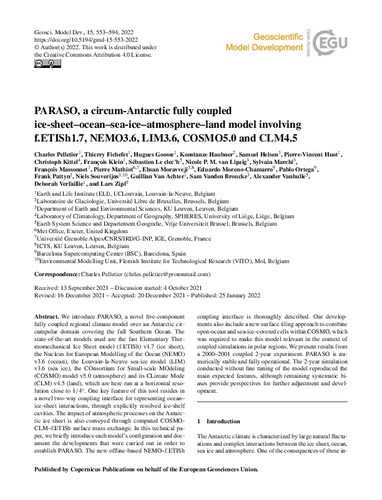Mostra el registre d'ítem simple
PARASO, a circum-Antarctic fully coupled ice-sheet–ocean–sea-ice–atmosphere–land model involving f.ETISh1.7, NEMO3.6, LIM3.6, COSMO5.0 and CLM4.5
| dc.contributor.author | Pelletier, Charles |
| dc.contributor.author | Fichefet, Thierry |
| dc.contributor.author | Goosse, Hugues |
| dc.contributor.author | Haubner, Konstanze |
| dc.contributor.author | Helsen, Samuel |
| dc.contributor.author | Huot, Pierre-Vincent |
| dc.contributor.author | Kittel, Christoph |
| dc.contributor.author | Klein, François |
| dc.contributor.author | Moreno Chamarro, Eduardo |
| dc.contributor.author | Ortega Montilla, Pablo |
| dc.contributor.other | Universitat Politècnica de Catalunya. Departament de Física |
| dc.contributor.other | Barcelona Supercomputing Center |
| dc.date.accessioned | 2022-03-03T14:30:00Z |
| dc.date.available | 2022-03-03T14:30:00Z |
| dc.date.issued | 2022-01-25 |
| dc.identifier.citation | Pelletier, C. [et al.]. PARASO, a circum-Antarctic fully coupled ice-sheet–ocean–sea-ice–atmosphere–land model involving f.ETISh1.7, NEMO3.6, LIM3.6, COSMO5.0 and CLM4.5. "Geoscientific model development", 25 Gener 2022, vol. 15, núm. 2, p. 553-594. |
| dc.identifier.issn | 1991-9603 |
| dc.identifier.uri | http://hdl.handle.net/2117/363385 |
| dc.description.abstract | We introduce PARASO, a novel five-component fully coupled regional climate model over an Antarctic circumpolar domain covering the full Southern Ocean. The state-of-the-art models used are the fast Elementary Thermomechanical Ice Sheet model (f.ETISh) v1.7 (ice sheet), the Nucleus for European Modelling of the Ocean (NEMO) v3.6 (ocean), the Louvain-la-Neuve sea-ice model (LIM) v3.6 (sea ice), the COnsortium for Small-scale MOdeling (COSMO) model v5.0 (atmosphere) and its CLimate Mode (CLM) v4.5 (land), which are here run at a horizontal resolution close to 1/4°. One key feature of this tool resides in a novel two-way coupling interface for representing ocean–ice-sheet interactions, through explicitly resolved ice-shelf cavities. The impact of atmospheric processes on the Antarctic ice sheet is also conveyed through computed COSMO-CLM–f.ETISh surface mass exchange. In this technical paper, we briefly introduce each model's configuration and document the developments that were carried out in order to establish PARASO. The new offline-based NEMO–f.ETISh coupling interface is thoroughly described. Our developments also include a new surface tiling approach to combine open-ocean and sea-ice-covered cells within COSMO, which was required to make this model relevant in the context of coupled simulations in polar regions. We present results from a 2000–2001 coupled 2-year experiment. PARASO is numerically stable and fully operational. The 2-year simulation conducted without fine tuning of the model reproduced the main expected features, although remaining systematic biases provide perspectives for further adjustment and development. |
| dc.description.sponsorship | This research has been supported by the Fonds De La Recherche Scientifique – FNRS (grant no. O0100718F). |
| dc.format.extent | 42 p. |
| dc.language.iso | eng |
| dc.publisher | European Geosciences Union (EGU) |
| dc.rights | Attribution 4.0 International |
| dc.rights.uri | https://creativecommons.org/licenses/by/4.0/ |
| dc.subject | Àrees temàtiques de la UPC::Física |
| dc.subject | Àrees temàtiques de la UPC::Informàtica::Aplicacions de la informàtica |
| dc.subject.lcsh | Climatology -- Mathematical models |
| dc.subject.other | Climate modeling |
| dc.subject.other | Ice sheet |
| dc.subject.other | Ice shelf |
| dc.subject.other | Ice-ocean interaction |
| dc.subject.other | Polar region |
| dc.subject.other | Sea ice |
| dc.title | PARASO, a circum-Antarctic fully coupled ice-sheet–ocean–sea-ice–atmosphere–land model involving f.ETISh1.7, NEMO3.6, LIM3.6, COSMO5.0 and CLM4.5 |
| dc.type | Article |
| dc.subject.lemac | Climatologia -- Models matemàtics |
| dc.identifier.doi | 10.5194/gmd-15-553-2022 |
| dc.description.peerreviewed | Peer Reviewed |
| dc.relation.publisherversion | https://gmd.copernicus.org/articles/15/553/2022/gmd-15-553-2022.html |
| dc.rights.access | Open Access |
| local.identifier.drac | 32848033 |
| dc.description.version | Postprint (published version) |
| local.citation.author | Pelletier, C.; Fichefet, T.; Goosse, H.; Haubner, K.; Helsen, S.; Huot, P.; Kittel, C.; Klein, F.; Moreno, E.; Ortega, P. |
| local.citation.publicationName | Geoscientific model development |
| local.citation.volume | 15 |
| local.citation.number | 2 |
| local.citation.startingPage | 553 |
| local.citation.endingPage | 594 |
| dc.description.authorship | Article signat per 23 autors/es: Charles Pelletier (1), Thierry Fichefet (1), Hugues Goosse (1), Konstanze Haubner (2), Samuel Helsen (3), Pierre-Vincent Huot (1), Christoph Kittel (4), François Klein (1), Sébastien Le clec'h (5), Nicole P. M. van Lipzig (3), Sylvain Marchi (3), François Massonnet (1), Pierre Mathiot (6,7), Ehsan Moravveji (3,8), Eduardo Moreno-Chamarro (9), Pablo Ortega (9), Frank Pattyn (2), Niels Souverijns (3,10), Guillian Van Achter (1), Sam Vanden Broucke (3), Alexander Vanhulle (5), Deborah Verfaillie (1), and Lars Zipf (2) // (1) Earth and Life Institute (ELI), UCLouvain, Louvain-la-Neuve, Belgium / (2) Laboratoire de Glaciologie, Université Libre de Bruxelles, Brussels, Belgium / (3) Department of Earth and Environmental Sciences, KU Leuven, Leuven, Belgium / (4) Laboratory of Climatology, Department of Geography, SPHERES, University of Liège, Liège, Belgium / (5) Earth System Science and Departement Geografie, Vrije Universiteit Brussel, Brussels, Belgium, (6) Met Office, Exeter, United Kingdom / (7) Université Grenoble Alpes/CNRS/IRD/G-INP, IGE, Grenoble, France / (8) ICTS, KU Leuven, Leuven, Belgium / (9) Barcelona Supercomputing Center (BSC), Barcelona, Spain / (10) Environmental Modelling Unit, Flemish Institute for Technological Research (VITO), Mol, Belgium |
Fitxers d'aquest items
Aquest ítem apareix a les col·leccions següents
-
Articles de revista [390]
-
Articles de revista [2.208]


